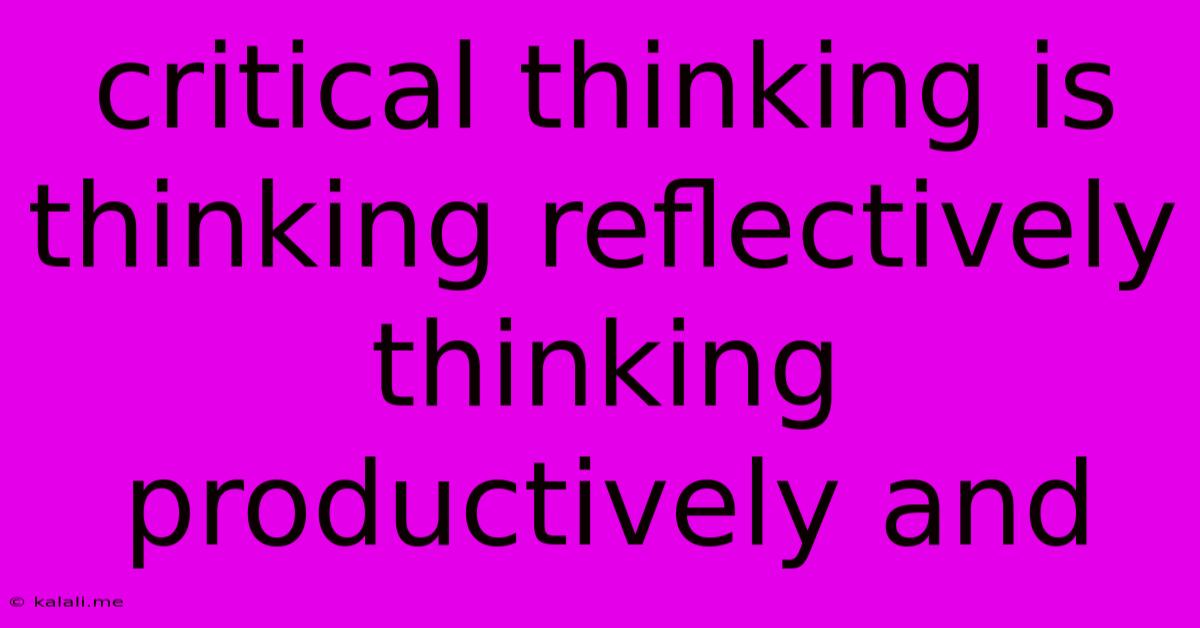Critical Thinking Is Thinking Reflectively Thinking Productively And
Kalali
Jun 14, 2025 · 3 min read

Table of Contents
Critical Thinking: Thinking Reflectively and Productively
Meta Description: Learn how critical thinking combines reflective and productive thought processes to solve problems effectively. Discover key skills and strategies for cultivating stronger critical thinking abilities.
Critical thinking is more than just thinking; it's a deliberate process of engaging with information and ideas to form judgments and make decisions. It's not simply about accepting information at face value, but actively questioning, analyzing, and evaluating it. This involves two crucial components: reflective thinking and productive thinking. These aren't mutually exclusive; instead, they work in tandem to achieve insightful conclusions.
Reflective Thinking: The Foundation of Critical Analysis
Reflective thinking forms the bedrock of critical thinking. It's the process of carefully considering your own thoughts, beliefs, and assumptions. It involves:
- Self-awareness: Recognizing your own biases, prejudices, and preconceived notions. Understanding how these might influence your interpretations.
- Introspection: Examining your thought processes. Asking yourself: "How did I reach this conclusion? What evidence supports it? What are the potential flaws in my reasoning?"
- Analysis of experiences: Reflecting on past experiences and learning from them. Identifying patterns and drawing insights.
- Open-mindedness: Willingness to consider alternative perspectives and challenge your own beliefs. Avoiding confirmation bias – the tendency to seek out information that confirms existing beliefs and ignore contradictory evidence.
Productive Thinking: Building Solutions and Generating Ideas
While reflective thinking provides the foundation, productive thinking builds upon it to generate solutions and create new knowledge. This involves:
- Problem-solving: Identifying the core problem, generating potential solutions, evaluating their feasibility, and selecting the best option.
- Creative thinking: Generating novel ideas and approaches to problems. Thinking outside the box and challenging conventional wisdom.
- Decision-making: Weighing the pros and cons of different options and making informed decisions based on evidence and sound reasoning.
- Synthesizing information: Combining information from different sources to form a comprehensive understanding. Connecting seemingly disparate ideas to create new insights.
Key Skills for Cultivating Critical Thinking
Developing strong critical thinking skills is an ongoing process. Here are some essential skills to cultivate:
- Analysis: Breaking down complex information into smaller, manageable parts to understand its components.
- Interpretation: Understanding the meaning and significance of information. Considering context and implications.
- Inference: Drawing logical conclusions based on evidence and reasoning. Making educated guesses based on available data.
- Evaluation: Assessing the credibility, reliability, and validity of information. Identifying biases and weaknesses in arguments.
- Explanation: Clearly and concisely communicating your reasoning and conclusions to others. Justifying your judgments with evidence.
Integrating Reflective and Productive Thinking in Practice
The power of critical thinking lies in the seamless integration of reflective and productive processes. For example, when facing a complex problem:
- Reflect: Start by examining your own assumptions and biases. What do you already know about this problem? What are your initial reactions?
- Analyze: Break down the problem into smaller, more manageable parts. Gather relevant information from multiple sources.
- Generate ideas: Brainstorm potential solutions. Explore different approaches and perspectives.
- Evaluate: Assess the feasibility and effectiveness of each potential solution. Consider the potential consequences of each option.
- Decide and Act: Select the best solution based on your analysis and evaluation. Implement your chosen solution and monitor its effectiveness.
- Reflect Again: After implementing the solution, reflect on the process. What did you learn? What could you have done differently? This continuous cycle of reflection and action is crucial for improving critical thinking skills.
By consistently practicing these skills and integrating reflective and productive thinking, you can significantly enhance your ability to analyze information, solve problems, and make sound judgments – crucial skills in all aspects of life.
Latest Posts
Latest Posts
-
Moment Of Inertia For Rectangular Beam
Jun 14, 2025
-
Least Common Multiple Of 8 And 30
Jun 14, 2025
-
Neap Tides Result When The Moon Is
Jun 14, 2025
-
E Book Vs Print Book Advantages And Disadvantages
Jun 14, 2025
-
Which Of The Following Is Not True Of Emotional Intelligence
Jun 14, 2025
Related Post
Thank you for visiting our website which covers about Critical Thinking Is Thinking Reflectively Thinking Productively And . We hope the information provided has been useful to you. Feel free to contact us if you have any questions or need further assistance. See you next time and don't miss to bookmark.